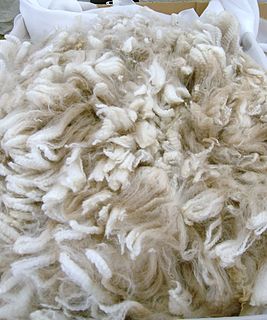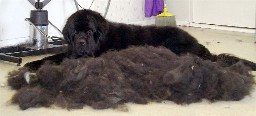
Fiber or fibre is a natural or artificial substance that is significantly longer than it is wide. Fibers are often used in the manufacture of other materials. The strongest engineering materials often incorporate fibers, for example carbon fiber and ultra-high-molecular-weight polyethylene.

Velvet is a type of woven tufted fabric in which the cut threads are evenly distributed, with a short pile, giving it a distinctive soft feel. By extension, the word velvety means "smooth like velvet". In the past, velvet was typically made from silk. Today, velvet can be made from linen, cotton, wool and synthetic fibers.

Cosmetics are constituted mixtures of chemical compounds derived from either natural sources, or synthetically created ones. Cosmetics have various purposes. Those designed for personal care and skin care can be used to cleanse or protect the body or skin. Cosmetics designed to enhance or alter one's appearance (makeup) can be used to conceal blemishes, enhance one's natural features, add color to a person's face, or change the appearance of the face entirely to resemble a different person, creature or object. Cosmetics can also be designed to add fragrance to the body.
Fiberglass or fibreglass is a common type of fiber-reinforced plastic using glass fiber. The fibers may be randomly arranged, flattened into a sheet called a chopped strand mat, or woven into glass cloth. The plastic matrix may be a thermoset polymer matrix—most often based on thermosetting polymers such as epoxy, polyester resin, or vinyl ester resin—or a thermoplastic.
Synthetic fibers or synthetic fibres are fibers made by humans through chemical synthesis, as opposed to natural fibers that are directly derived from living organisms, such as plants or fur from animals. They are the result of extensive research by scientists to replicate naturally occurring animal and plant fibers. In general, synthetic fibers are created by extruding fiber-forming materials through spinnerets, forming a fiber. These are called synthetic or artificial fibers. The word polymer comes from a Greek prefix "poly" which means "many" and suffix "mer" which means "single units"..

Microfiber is synthetic fiber finer than one denier or decitex/thread, having a diameter of less than ten micrometers. A strand of silk is about one denier and about a fifth of the diameter of a human hair.
Skin disorders are among the most common health problems in dogs, and have many causes. The condition of a dog's skin and coat is also an important indicator of its general health. Skin disorders of dogs vary from acute, self-limiting problems to chronic or long-lasting problems requiring life-time treatment. Skin disorders may be primary or secondary in nature, making diagnosis complicated.

Qiviuq [sg] or qiviut [pl] is the inner wool of the muskox. In Inuinnaqtun the same word can be used to refer any down such as the down feathers of birds.

Natural fibers or natural fibres are fibers that are produced by geological processes, or from the bodies of plants or animals. They can be used as a component of composite materials, where the orientation of fibers impacts the properties. Natural fibers can also be matted into sheets to make paper or felt.

A shaving brush or shave brush is a small brush with a handle parallel to the bristles used to make lather from shaving soap or shaving cream and apply it to the face when shaving. Shave brushes are often decorative; antique handles are often made from materials such as ivory or even gold, though the bristle load may be composed of any number of natural or synthetic materials. The shave brush is used most often today by "wet shavers" in tandem with a single- or double-edged safety razor or a straight razor. However, this is not always the case, as shavers of all varieties may employ the tool.

Animal fibers are natural fibers that consist largely of certain proteins. Examples include silk, hair/fur and feathers. The animal fibers used most commonly both in the manufacturing world as well as by the hand spinners are wool from domestic sheep and silk. Also very popular are alpaca fiber and mohair from Angora goats. Unusual fibers such as Angora wool from rabbits and Chiengora from dogs also exist, but are rarely used for mass production.

A sponge is a tool or cleaning aid made of soft, porous material. Typically used for cleaning impervious surfaces, sponges are especially good at absorbing water and water-based solutions.

Alpaca fleece is the natural fiber harvested from an alpaca. There are two different types of alpaca fleece. The most common fleece type comes from a Huacaya. Huacaya fiber grows and looks similar to sheep wool in that the animal looks "fluffy". The second type of alpaca is Suri and makes up less than 10% of the South American alpaca population. Suri fiber is more similar to natural silk and hangs off the body in locks that have a dreadlock appearance. While both fibers can be used in the worsted milling process using light weight yarn or thread, Huacaya fiber can also be used in a woolen process and spun into various weight yarns. It is a soft, durable, luxurious and silky natural fiber.

In textile manufacturing, finishing refers to the processes that convert the woven or knitted cloth into a usable material and more specifically to any process performed after dyeing the yarn or fabric to improve the look, performance, or "hand" (feel) of the finish textile or clothing. The precise meaning depends on context.

Dog grooming refers to both the hygienic care and cleaning of a dog, as well as a process by which a dog's physical appearance is enhanced for showing or other types of competition. A dog groomer is a person who earns their living grooming dogs.

A makeup brush is a tool with bristles, used for the application of makeup or face painting. The bristles may be made out of natural or synthetic materials, while the handle is usually made out of plastic or wood. When cosmetics are applied using the appropriate brush, they blend better onto the skin.
Beard oil is a cosmetic product for men that is used to nourish both the skin under the beard and the beard itself in order to keep it "soft, shiny, and smooth". Beard oil mimics the natural oils produced by skin, such as sebum, and is composed mainly of carrier oils and essential oils.

A paintbrush is a brush used to apply paint or ink. A paintbrush is usually made by clamping bristles to a handle with a ferrule. They are available in various sizes, shapes, and materials. Thicker ones are used for filling in, and thinner ones are used for details. They may be subdivided into decorators' brushes used for painting and decorating and artists' brushes use for visual art.
The conservation and restoration of leather objects is the process of determining the causes of deterioration, followed by deciding the best course of action for preserving the leather objects for the future.
The conservation and restoration of fur objects is the preservation and protection of objects made from or containing fur. These pieces can include personal items like fur clothing or objects of cultural heritage that are housed in museums and collections. When dealing with the latter, a conservator-restorer often handles their care, whereas, for the public, professional furriers can be found in many neighborhoods.












